GIGABYTE BRIX GB-BXBT-1900 Review: A Bay Trail UCFF PC
by Ganesh T S on October 24, 2014 12:10 PM ESTPerformance Metrics - II
In this section, we mainly look at benchmark modes in programs used on a day-to-day basis, i.e, application performance and not synthetic workloads.
x264 Benchmark
First off, we have some video encoding benchmarks courtesy of x264 HD Benchmark v5.0. This is simply a test of CPU performance. As expected, the Celeron J1900 with active cooling performs about twice as better as the passively cooled LIVA, but can't match the Haswell CPUs in the other mini-PCs.
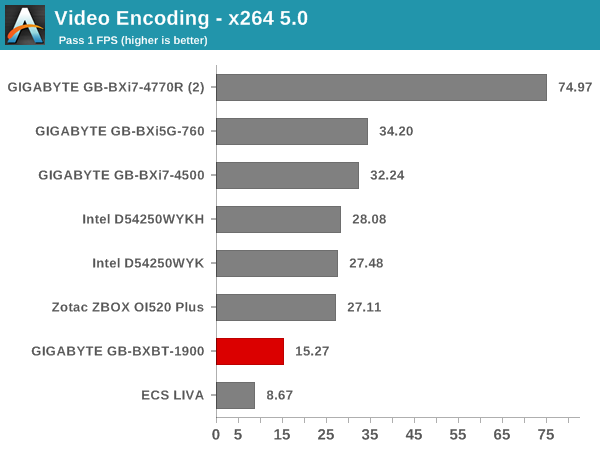
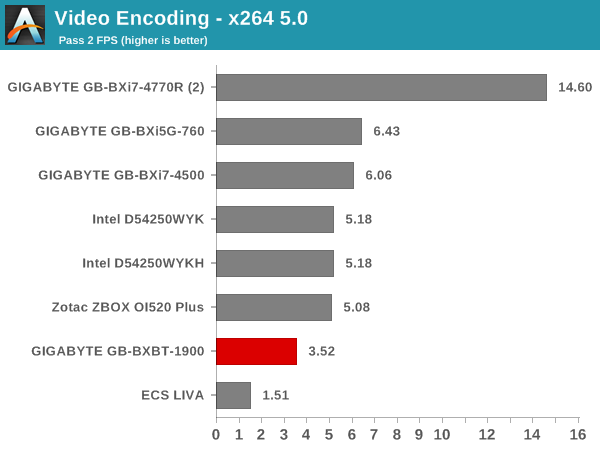
7-Zip
7-Zip is a very effective and efficient compression program, often beating out OpenCL accelerated commercial programs in benchmarks even while using just the CPU power. 7-Zip has a benchmarking program that provides tons of details regarding the underlying CPU's efficiency. In this subsection, we are interested in the compression and decompression MIPS ratings when utilizing all the available threads. The presence of four distinct cores helps the unit move to the middle of the pack in the decompression ratings.
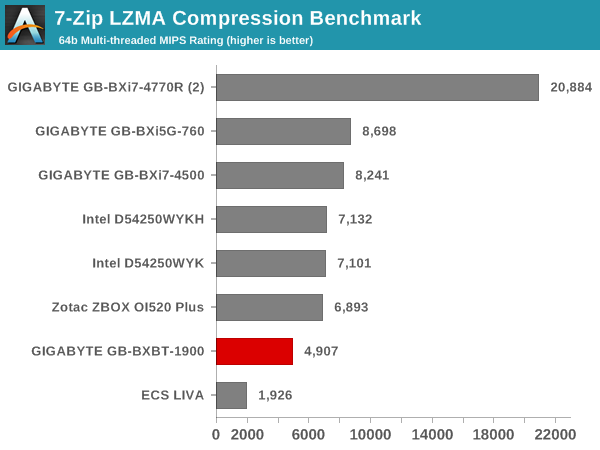
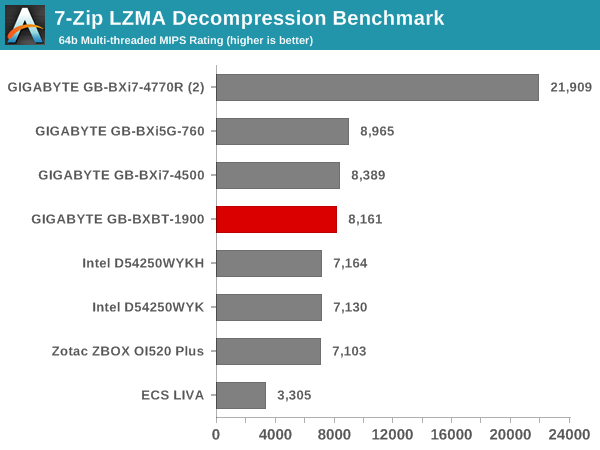
TrueCrypt
As businesses (and even home consumers) become more security conscious, the importance of encryption can't be overstated. CPUs supporting the AES-NI instruction for accelerating the encryption and decryption processes have, till now, been the higher end SKUs. However, with Silvermont, even the lowly Atom series has gained support for AES-NI in some SKUs. Unfortunately, AES-NI is not a feature available in Bay Trail-D. AES operations have to be done in software. TrueCrypt, a popular open-source disk encryption program can take advantage of the AES-NI capabilities, but fall back to a software implementation in the absence of AES-NI. The TrueCrypt internal benchmark provides some interesting cryptography-related numbers to ponder. In the graph below, we can get an idea of how fast a TrueCrypt volume would behave in the GIGABYTE GB-BXBT-1900 and how it would compare with other select PCs. This is a purely CPU feature / clock speed based test.

Agisoft Photoscan
Agisoft PhotoScan is a commercial program that converts 2D images into 3D point maps, meshes and textures. The program designers sent us a command line version in order to evaluate the efficiency of various systems that go under our review scanner. The command line version has two benchmark modes, one using the CPU and the other using both the CPU and GPU (via OpenCL). The benchmark takes around 50 photographs and does four stages of computation:
- Stage 1: Align Photographs
- Stage 2: Build Point Cloud (capable of OpenCL acceleration)
- Stage 3: Build Mesh
- Stage 4: Build Textures
We record the time taken for each stage. Since various elements of the software are single threaded, others multithreaded, and some use GPUs, it is interesting to record the effects of CPU generations, speeds, number of cores, DRAM parameters and the GPU using this software.

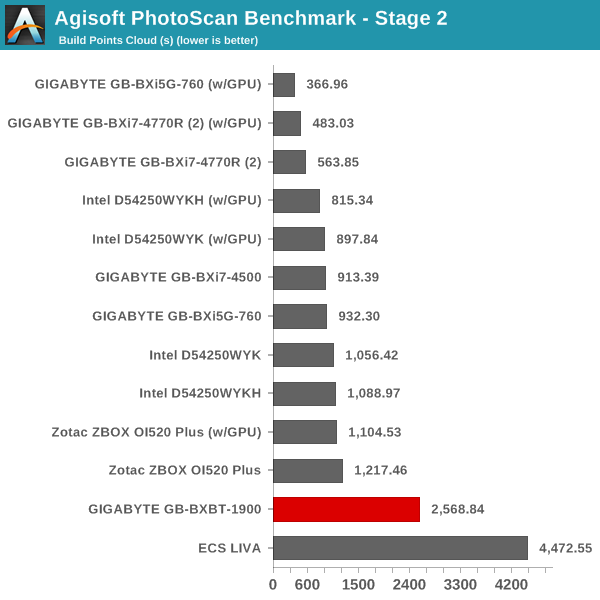
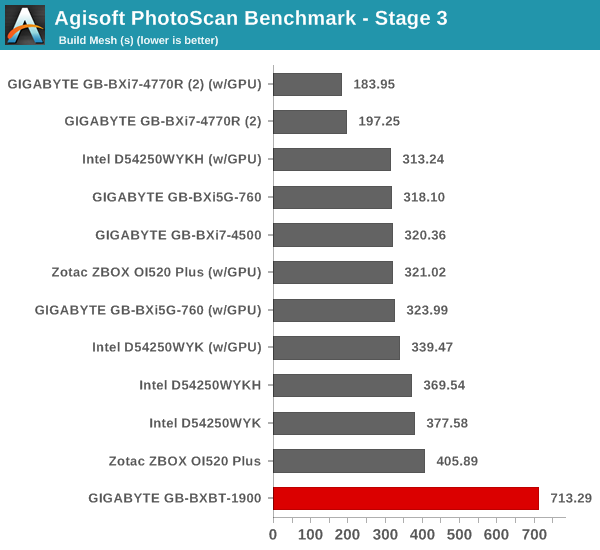
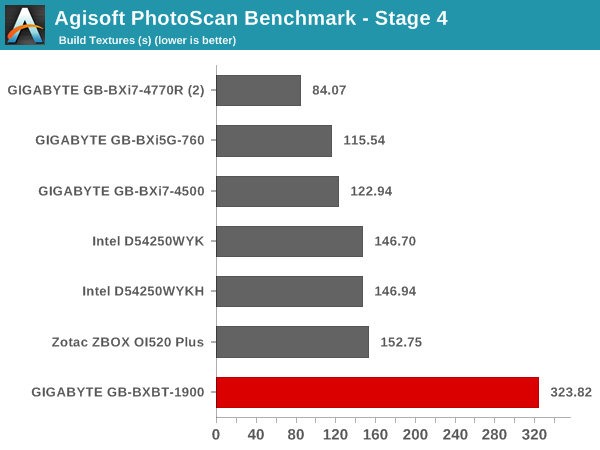
Dolphin Emulator
Wrapping up our application benchmark numbers is the Dolphin Emulator benchmark mode results. This is again a test of the CPU capabilities, and the trend seen in earlier CPU-focused workload graphs are evident here also.











35 Comments
View All Comments
xistic - Friday, October 24, 2014 - link
How does something like this compare to an old Intel Core Duo with 4GB of RAM? I've got a headless linux box I'm looking to replace. Currently the Core Duo is overkill for what I use it for. (Team Fortress 2 MvM, jabber, Rhodecode and Teamspeak servers all with low traffic. Seriously, never get above 20% CPU and 25% RAM consumed.)kpb321 - Friday, October 24, 2014 - link
You can see for yourself at:http://www.anandtech.com/bench/product/1227?vs=60
Single threaded performance seems to be ~half that of a Core Duo but as the J1900 is a quad core chip it's multi-threaded performance is a little bit better.
lioncat55 - Friday, October 24, 2014 - link
While I don't have any numbers that is not the right chip. You are looking at a Core 2 Duo and not a Core Due. You are also looking at a Core 2 Duo part that has a higher base clock than the J1900 has boost.A better look would be the http://www.anandtech.com/bench/product/1227?vs=64. Its bast clock is 2.4Ghz.
xistic - Friday, October 24, 2014 - link
I forgot there was a difference. It's a Core 2 Duo.xistic - Friday, October 24, 2014 - link
And thank you, this answers my question.LostAlone - Saturday, October 25, 2014 - link
Personally I wouldn't be looking to spend anything to replace a headless box unless you need more performance. I mean, I know that having a tower instead of micro-box isn't ideal, but you'd be throwing away all the benefits of having a more powerful system too, like being able to handle more traffic (say you invite a bunch of people to you TS server for a specific event) and whatever else you may possibly want to do in the future.A core 2 duo is a nice chip, and certainly would be up for doing some light media serving and transcoding duties if that's what you want to do, probably the most stressful home-server activities. Maybe that's not what you want to do right now, but having the choice to add those capabilities is great.
From my point of view moving to a system this underpowered would strictly be a downgrade. It'll cost you money to do the same exact thing you are doing now, and has none of the potential for expansion.
Ratman6161 - Sunday, October 26, 2014 - link
I don't know what they will charge for this if/when it ever comes to the US but the MSRP listed in the story is more than I paid for an Ivy Bridge i3 model a couple of years ago. Could probably get an i3 for the same or not much more and would probably be a better choice unless you needed that ability to do an internal 2.5 inch drive.zepi - Friday, October 24, 2014 - link
I'm trying to read the network performance evaluation, but i can only find that your router is 5GHz prefered, but nowhere does it state if this particular Realtek supports it or not.Often in cities 2.4GHz spectrum is totally blocked and any 5GHz is faster than 3x3 2.4GHz resticted 802.11n setup.
Ofc this is not a problem in suburbs. Basically in most places i've lived over the last few years 2.4GHz is pretty much unusable with huge packet loss and speeds down to single digit megabits due to interference from neighbours. 5GHz band is less problematic as it mostly stays inside owners walls.
Ryan Smith - Friday, October 24, 2014 - link
The Realtek radio is 2.4GHz only.ganeshts - Friday, October 24, 2014 - link
This is a 2.4 GHz only single band mPCIe card. Realtek RTL8723BEWill make a note to add single or dual band nature in the table on the first page in future articles